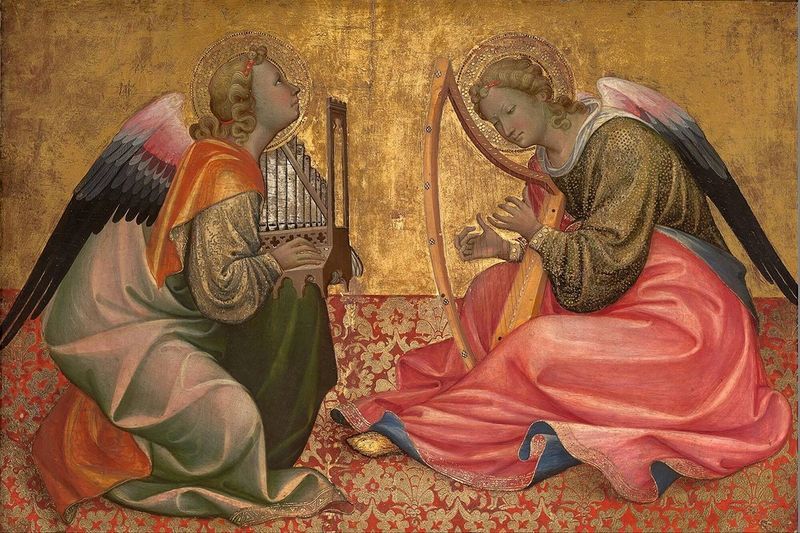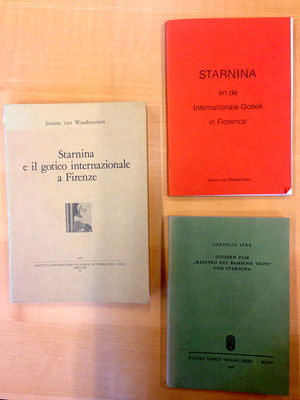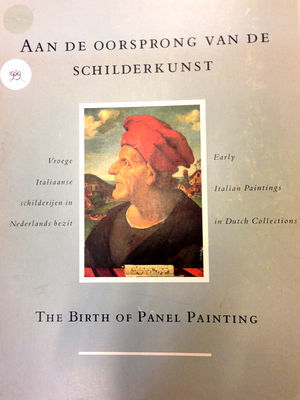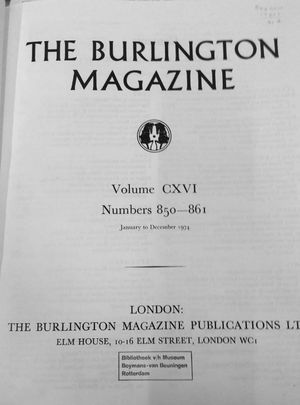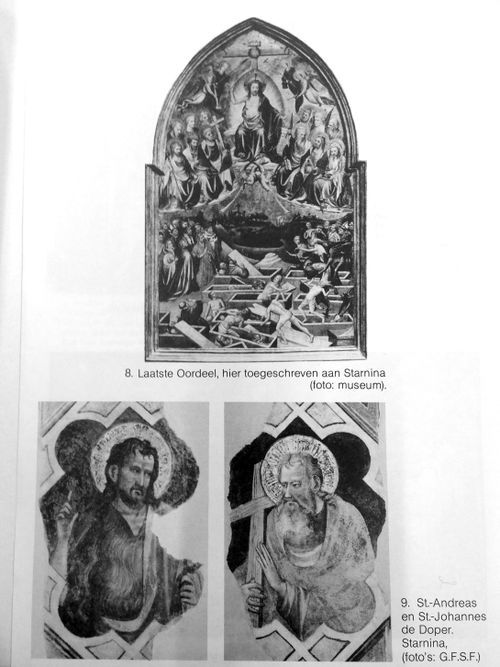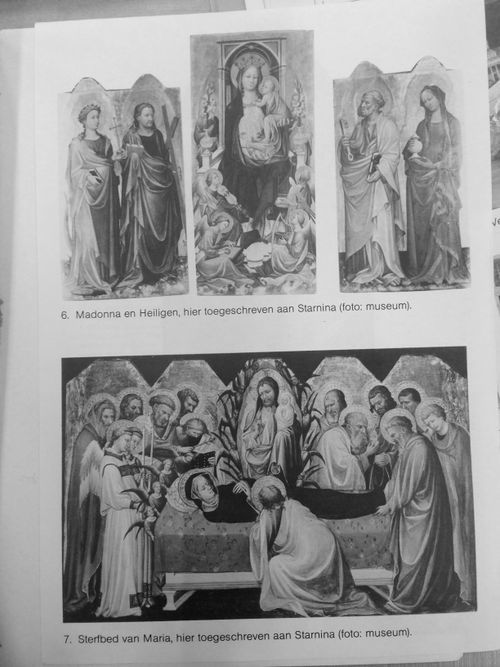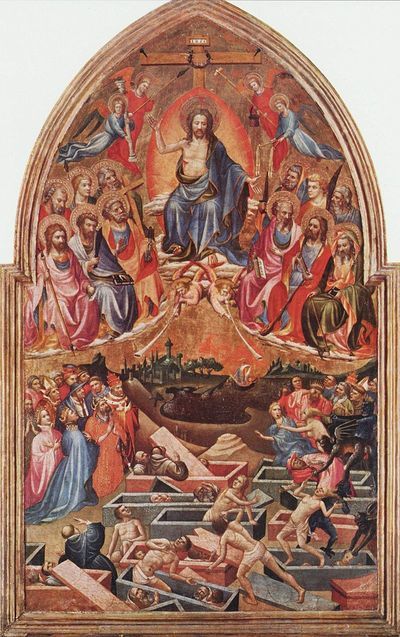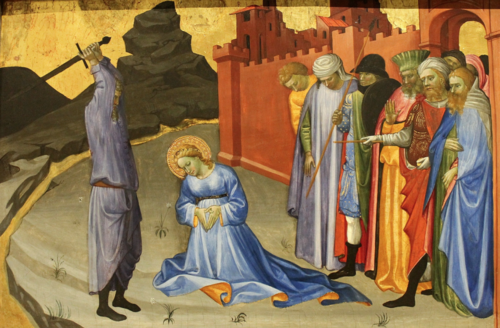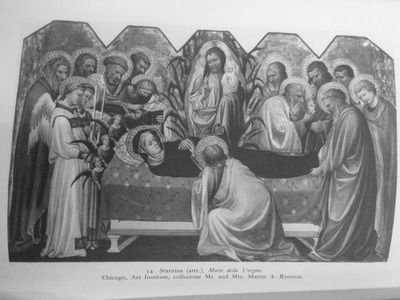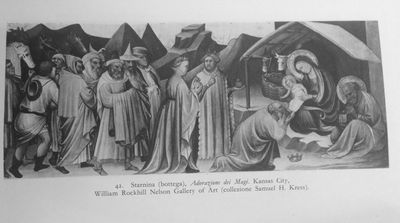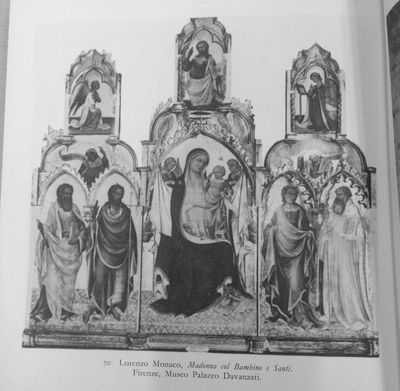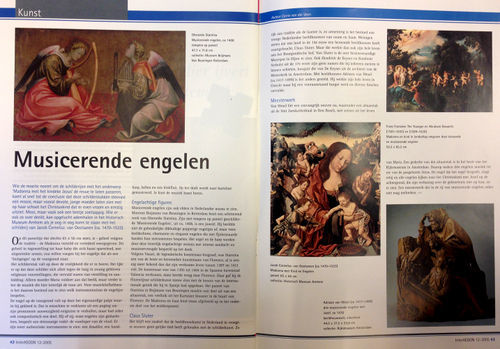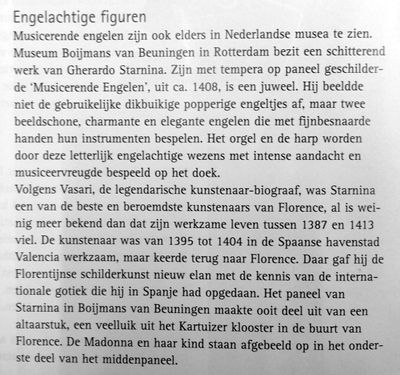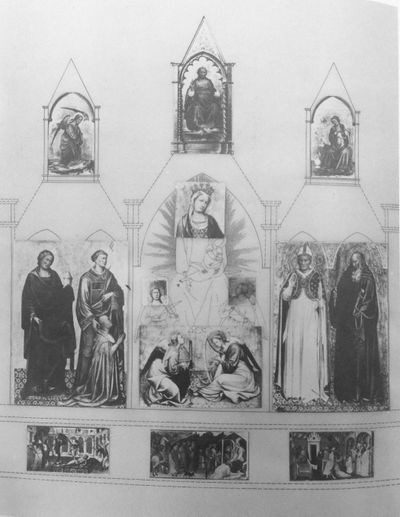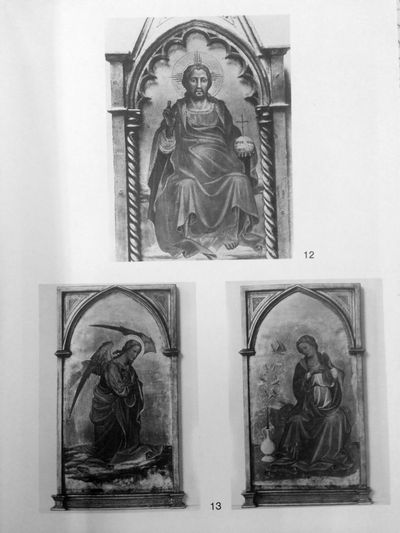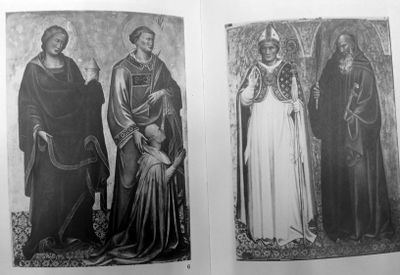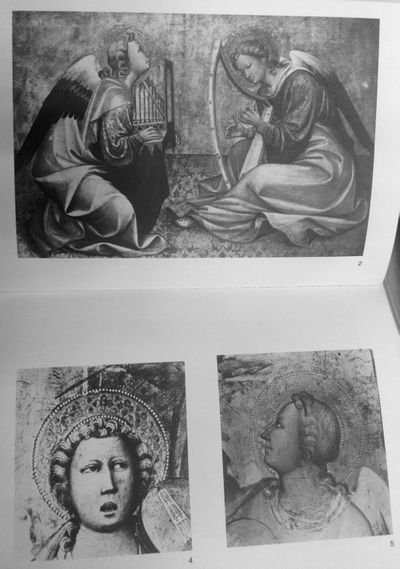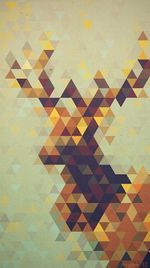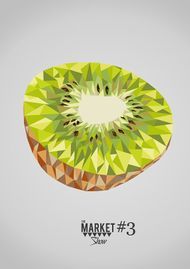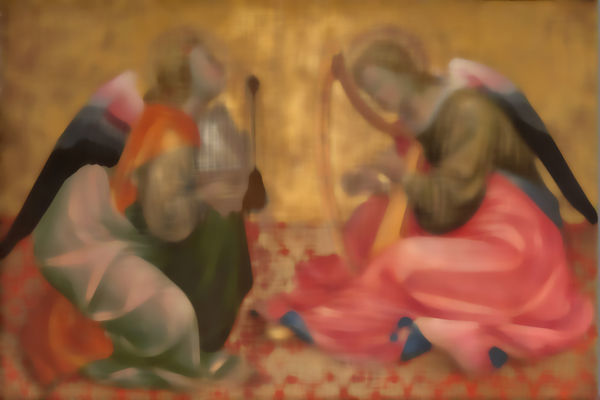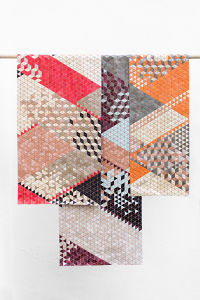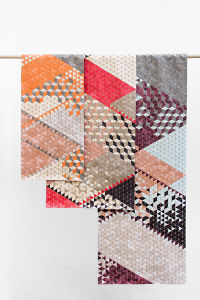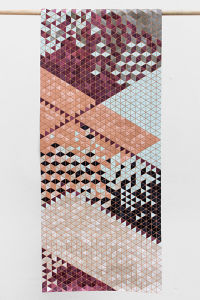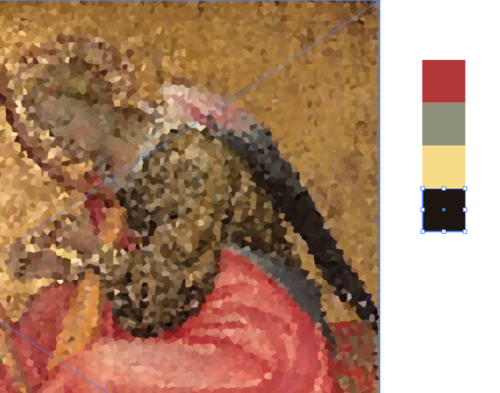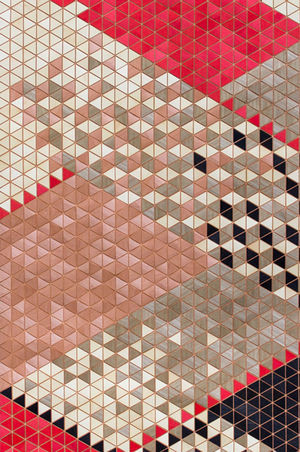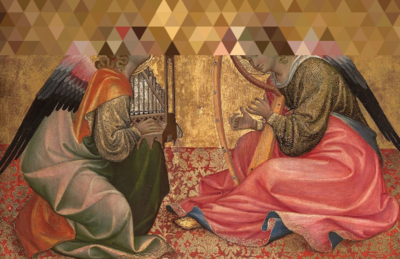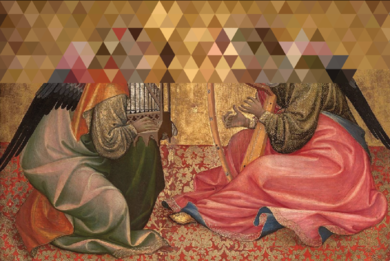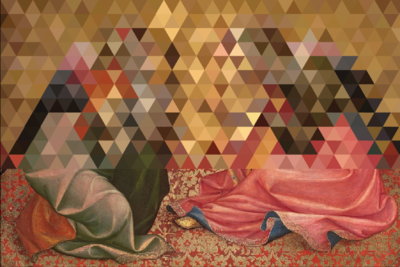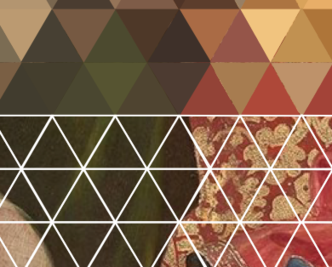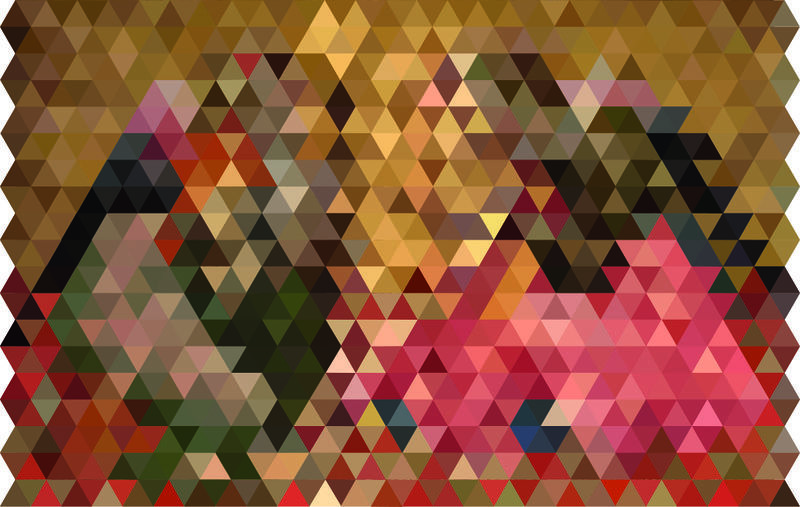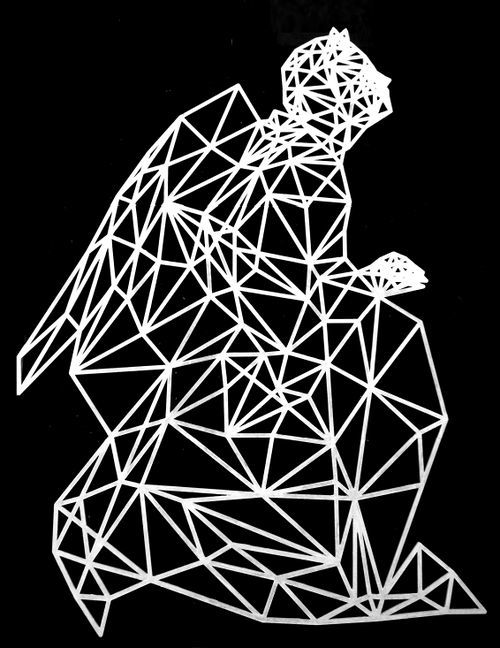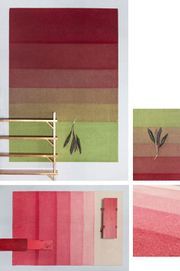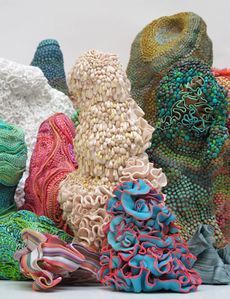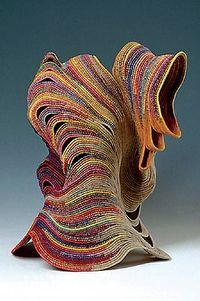Process Fantastic Forgeries
Contents
Artifact
Gherardo Starnina - Twee op de grond zittende, musicerende engelen
Instruments: Organ (orgel) & Harp
Research
Who is Gherardo Starnina?
Source: http://collectie.boijmans.nl/nl/collection/2557-(ok)
Het paneel maakte oorspronkelijk deel uit van een altaarstuk, een polyptiek ofwel veelluik. De engelen bespelen instrumenten, links een klein orgel en rechts een harp. De omhoog gerichte blik van de linkerengel is een aanduiding van de grotere compositie, waar zij ooit deel van waren.
Volgens Vasari was Gherardo di Jacopo Starnina één van de beroemdste en beste schilders van Florence. Starnina was van 1395 tot 1406 werkzaam in Valencia. In de Spaanse havenstad had hij kennis gemaakt met de Internationale Stijl, die in 1393 door de Duitse schilder Marçal de Sas aldaar was geïntroduceerd. Na zijn terugkeer in Florence gaf Starnina met zijn kalligrafische lijnvoering en delicate expressiviteit een nieuwe impuls aan de Florentijnse schilderkunst. Hij bevrijdde haar van de levenloze formules die van Giotto's grootse stijl waren overgebleven. Zowel Lorenzo Monaco als Lorenzo Ghiberti werden gevormd door Starnina's stijl.
Titel: Twee op de grond zittende, musicerende engelen Schilder: Gherardo Starnina, Florence 1354/1360 - Florence 1409/1413 Jaartal: 1400 - 1410 Locatie: Dit object is te zien in zaal 03 Objectsoort: schilderij Inventarisnummer: 2557 (OK) Afmetingen: 47,7 x 71,8 cm Materiaal en techniek: tempera op paneel Creditline: Verworven met de verzameling van / Acquired with the collection of: D.G. van Beuningen 1958 Collectie: Oude Kunst Tentoonstellingen: De Collectie Verrijkt (2011)
Source: https://en.wikipedia.org/wiki/Gherardo_StarninaGherardo Starnina
This is what Wikipedia has to say about Gherardo Starnina:
Gherardo Starnina (c. 1360–1413)[1] was an Italian painter from Florence in the Quattrocento era. According to the biographer Giorgio Vasari, Starnina initially trained with Antonio Veneziano, then with Agnolo Gaddi. He is claimed to have participated in the painting of the frescos in the Castellani Chapel in Basilica di Santa Croce, Florence. He is also said to have moved to Spain in 1380 to work under Juan I of Castile, and is attributed some painting in the San Blas chapel of the Cathedral of Toledo. Several paintings formerly attributed to the Master of the Bambino Vispo are now attributed to Gherardo Starnina, and the two artists may have been the same person.
This information is a little bit vague still, and there is not much to find about him on the internet, so I went to the Boijmans van Beuningen museum and searched for information in their library. These are my findings:
Source text and image: Starnina en de Internationale Gotiek in Florence (Academisch proefschrift) p.9 - p.13, Author: Jeanne van waadenoijen 1980 Amsterdam
Internationale stijl en de florentijnse schilderkunst omstreeks 1400 De terugkeer van de Florentijnse schilder Gherardo Starnina in Florence tussen 1401 en 1404 van betekenis zou zijn geweest voor Lorenzo Monaco. Van Starnina staat vast dat hij vele jaren in Spanje heeft gewerkt en wel voornamelijk in Valencia.
Dat er van Starnina vrijwel geen werk bekend was, kon men met deze gegevens in verband met zijn stijl aanvankelijk weinig aanvangen. Op grond van hetgeen men van hem wist, had men bovendien een persoonlijkheid gecreëerd die niet direct een inspiratiebron voor de Internationale Stijl in Florence geweest kon zijn. Dat Starnina evenwel voor de Internationale Gotiek in Florence niet onbelangrijk moet zijn geweest, werd bevestigd door de onverwachte vondst van een aantal frescofragmenten in de S. Stefano te Empoli op de plaats waar Starnina in 1409 een serie fresco’s had geschilderd.
Hierdoor rees opnieuw de vraag, die Schmarsow zich al een halve eeuw eerder had gesteld, maar waar toen geen bevredigend antwoord op was te geven: wie is Gherardo Starnina? Tevens zal een poging worden ondernomen duidelijk te maken waar Starnina’s stijll vandaan komt, wat zijn betekenis is geweest voor de schilderkunst in Florence aan het begin van de 15de eeuw en wat zijn rol is geweest bij de verspreiding van de Internationale Stijl in de kringen van de Florentijnse kunstenaars.
Vasari’s levensbeschrijving van Starnina. Gherardo Starnina werd in 1354 geboren. Na een leertijd bij Antonio Veneziano schilderde hij in de Castellani-kapel in de Sta. Croce te Florence fresco’s met voorstellingen uit het leven van de heiligen Antonius Abt en Nicolaas. [..] Voor de koning van Spanje schilderde hij vele zaken. [..] hij ging terug naar Florence. [..] Kort daarop schilderde hij de fresco’s in de St. -Hieronymuskapel in de Carmine. De Spaanse mode volgens welke sommige figuren gekleed waren, demonstreerde duidelijk dat Starnina in Spanje was geweest. Met deze fresco’s vestigde hij zijn naam.
A few works of Srarnina:
Source: Aan de oorsprong van de schilderkunst p.162 - p.164. Author: Rik Vos, Henk Os. SDU uitgeverij, ’s-gravenhage 1989
In the Dutch Institute in Florence, a young Dutch art historian, Jeanne van Waadenoijen, was doing research on the Master of Bambino Vispo. She had already discovered that there was something wrong about the identification of the altarpiece with angelic musicians. It was not the St. Lawrence Altarpiece of 1423 from the cathedral in Florence, but of a completely different altarpiece for another chapel of St. Lawrence, which is in the Certosa del Galluzzo, a Carthusian monastery in the neighborhood of Florence. Records show that this altarpiece was painted no less than 17 years earlier and by a painter who must be considered not as a pupil, but in certain respects as the master of Lorenzo Monaco, Gherardo Starnina. Vasari cites him as one of the most important Florentine artists from that period, who had worked in Spain and could therefore draw on artistic experiences which were completely new to Florence. Jeanne van Waadenoijen’s work changed the outlook on a crucial period of Florentine art history at a single stroke.The drapery, decorative richness and the sensitive facial expressions introduced by Starnina were given new expression by Lorenco Monaco through refinement of line and a bright color scheme which was unusual in Florence around 1400. A discovery of this sort with such far-reaching consequences for such an important area seldom occurs contemporary art history.
Source: The Burlington Magazine Volume CXVI 1974 p.82 - p.91, A proposal for Starnina: exit the Maestro del Bambino Vispo?
In 1904 Oswald Sirén attributed a number of early fifteenth century pictures. He considered the Maestro del Bambino Vispo to be one of the numerous followers of Lorenzo Monaco, but then a more original one. He tried twice to identify this anonymous master, with Pietro di Domenica da Montepulciano and Parri Spinelli. The name Maestro del Bambino Vispo had become widely accepted and many art historians added to his ouvre (his work). With this expansion of the ouvre it became increasingly obvious that it could not possibly have originated entirely under the influence of Lorenzo Monaco. It distinguished itself from Lorenzo Monaco’s works by an even stronger preference for long elegant folds, a lively expression and realistic personages. These elements, which may be considered unusual in Florentine painting of the first quarter, suggested that the artist was well acquainted with the International Gothic style as it manifested itself outside Florence. It wasn’t even clear if the Maestro was a Florentine, maybe he was Italian.
One work in particular gave rise to such doubts: ‘Last Judgement’, of Spanish provenance in Munich. This style was especially noticeable in the slightly bizarre facial types of the apostles, in their abundantly flowing draperies, and in the elegant appearance of the blessed, dressed in the height of fashion. This observation led the hypothesis that the artist’s origin should be looked for in Spain, possibly Valencia. Pudelko also observed that the Maestro del Bambino Vispo must have had considerable influence on Florentine painting of the first quarter of the century, even an influence on Lorenzo Monaco.
Yet, it cannot be denied that his art is strongly rooted in the Florentine Trecento tradition as far as iconography, composition and colour scheme are concerned. Where did the Maestro come from and how are the non-Florentine features in his work to be explained?
The hypothesis that the anonymous Maestro del Bambino Vispo was none other than Gherardo Starnina, a Florentine painter of great repute but practically without an oeuvre. As the biographical information on Starnina points to a considerably earlier period than that assumed for the Maestro del Bambino Vispo’s activity. It says Starnina must have died in or shortly before 1413. Other facts fit in remarkably well, like Starnina is known to have worked in Valencia, possibly even in France.
It was noted, however, that there existed resemblances between the works of the Maestro del Bambino Vispo and the fresco fragments of Starnina. Also the strong resemblance between the fresco fragments of Starnina and the Last Judgement does not only justify the latter’s attributioin to Starnina, but it also gives an indication as to its dating. The Carmine made in 1404, Empoli in 1409 and the Last Judgement was painted approximately between 1404 and 1409.
Source Image: https://www.flickr.com/photos/24364447@N05/16008417945/in/photostream/
Stylistic resemblances to Starnina’s frescoes can also be found in a predella panel of the Maestro del Bambino Vispo with the Beheading of a female Saint in London. The saint has a typical hairstyle which cannot be found in Florentine paining outside his works except in the frescoes in the Carmine.
Source: Starnina e il gotico internazionale a Firenze Author: Jeanne van Waadenoijen e Istituto Universitario Olandese di storia dell’Arte. 1983 Other works of Starnina are:
A work of Lorenzo Monaco, Madonna el Bambino e Santi:
Source: Magazine InterAEGON 12-2005
Engelachtige figuren Starnina beeldde niet de gebruikelijke dikbuikige popperige engeltjes af, maar twee beeldschone, charmante en elegante engelen die met fijnbesnaarde handen hun instrumenten bespelen. Het orgel en de harp worden door deze letterlijk engelachtige wezens met intense aandacht en musiceervreugde bespeeld op het doek.
Volgens Vasari (de legendarische kunstenaar- biograaf) was Starnina een van de beste en beroemdste kunstenaars van Florence, al is weinig meer bekend van dat zijn werkzame leven tussen 1387 en 1413 viel. Starnina was van 1395 tot 1404 in de Spaanse havenstad Valencia werkzaam, maar keerde terug naar Florence. Daar gaf hij de Florentijnse schilderkunst nieuw elan met de kennis van de internationale gotiek die hij in Spanje had opgedaan. Het paneel van Starnina in Boijmans van Beuningen maakte ooit deel uit van een altaarstuk, een veelluik uit het Kartuizer klooster in de buurt van Florence. De madonna en haar kind staan afgebeeld in het onderste deel van het midden paneel.
Source: Aan de oorsprong van de schilderkunst p.162 - p.164 Author: Rik Vos, Henk Os. SDU uitgeverij, ’s-gravenhage 1989
These two angelic musicians originally formed part of a larger picture. The angel on the left gazes upward towards somebody now absent, to whom he is obviously offering praise with his organ music. This must be Mary and the Christ-child who were represented there, because at that time angelic musicians had often appeared at the feet of Mary and her Son, since the end of the 14th century. This painting was attributed to an anonymous painter, the so-called Master of Bambino Vispo. It would seem that this painter without a name was one of the most important pupils of the famous Lorenzo Monaco, the artist who introduced the dynamic movement of line of the so-called International Gothic into Florentine painting. The altarpiece to which the fragment with the angels belonged, has been identified as the paining which pose adorned the altar of the chapel of St. Lawrence in the Cathedral in Florence. It appears from records that the chapel was consecrated in 1422 by Cardinal Orsini, and that the altarpiece was completed in 1423.
Source: Student zum ,,Meastro del bambino vispo’’ und Starnina, Author: Cornelia Syre, Rudolf Habelt Verlag GMBH Bonn 1979
This book gave an impression about the original altar piece the ‘Two seated angles making music’ were a part of:
Replica
Pixellating the painting through digital mediums
22/09: The copy will become a digital version of this painting. Made in Illustrator in a certain drawing stye.
Update 23/09: This is a simple approach and needs development. I will use digital techniques to pin point all the different colors, but in the end it will become something tangible, not only digital
Through the use of photoshop I put different filters on top of the painting, to see which effect it has on the colors and recognition of the painting
Filter Pixel Facet
Filter Pixel Fragmentation
Filter Pixel Kleur Halftoon
Filter Pixel Mezzotint
Filter Mozaïk
Filter Pointilleren
Filter Ruis Mediaan
Filter Pixel Kristal
This last filter could be a tool for the digital replica version, maybe I can laser cut all these triangles on a certain material and paint them in all the right colors. This filter made me think about this work:
Elisa Strozyk
This colorful table runner is made out of wood. And I am really fascinated by the bright colors and I think I could use this as an inspiration source for this project. Elisa experimented with different kinds of wood and after laser cutting the triangles, she'll stick every piece by hand on the fabric.
With the use of the Kristal filter on the painting, I can pin point each color and put it in a list In Illustrator I can select every color with the 'pipet' tool, this would only take me forever..
Pipet Tool
I can also choose to redo the Kristal filter and set the percentage higher, this is the outcome:
Filter Kristal 15%
Filter Kristal 20%
The 20% would be better for me to pin point down the colors. And if I can make this on a big scale, then it doesn't matter that you can't recognize the painting from a close distance, once you step further away your eyes will adapt and you will see all the pixels blend together until you do recognize the painting again.
If you take a closer look at Elisa's work, you see that all the triangles have the same size and are positioned in the same way. But the Kristal filter gives shapes of different sizes and different positions, I quite like this irregularity, so I might try this instead of the same measurements.
Update 01/10: First I want to analyze the work of Gherardo Starnina step by step, so that I understand what he has made.
In Illustrator I selected most of the colors out of the painting. The paining exists out of a lot of colors, I narrowed them down by making triangles and filled them with the right color.
The end result looks interesting, the angles aren't really recognizable even from a distance:
I want to categorize the colors and make five different color schemes: original, lighter, darker, brighter & softer.
Trangulation of the painting
I tried to transform the painting in to triangles, but not from the same size. Where there is more detail the triangles will look smaller, when there is less detail they will look bigger. For the replica I want to focus only on the left angle, because of the story that his head is up as a sign that this painting was part of a bigger altar piece.
Because the colors and different fabrics in the painting striked me the most, I want to fill some (or each) triangle with the fabric of the painting. I went out looking for the same fabrics, textures or colors.
Making the angle a 3D object
The triangulation of the angle looks very 3 dimensional, although my outcome is flat wood lasercut. After feedback I came to the conclusion to make a shot at Blender. Unfortunately deadline is almost there and it's the first time for me in Blender, so even with tutorial I found it difficult. So I'll make the object three dimensional myself.
The lasercut frame of the angle, I will use again, but this time as a base. Each point on the triangulation must have a different height when making it 3D. So I experimented with wooden sticks, after that I shaped chicken gaze over it so it becomes three dimensional. Unfortunately I only have a front view of the angle, so there is no back. (If I had more time I would make a backside). After the chicken gaze I stick paper to it with glue, and after it's dry, I form clay on top of it, to make it a solid object.
I want the sculpture to look different then most of the sculptures. I would like a bit of texture in it. That's why I added the clay in small pieces, without making it a smooth surface.
Transformation
22/09: Interesting parts of the paining are: the fabric details and the expression of all the different fabrics, the colors & gradients and the activities of the angles. The angles are making music and this element may come back in the end result. Transform the angles into textile objects/sculptures with a specific shape. Characteristics are texture, textile, color, shape and sound. Experiment with fabric manipulations. With the use of sensors the textile will move and play a sound when someone touches it in a certain way. One will represent the organ (orgel) and the other the harp. The objects will have organic shapes and move on the rhythm of the sounds, so it all looks quite natural but strange at the same time. They will be made of different textile techniques, knit, weave etc. Some by hand some by machine.
rENs & Desso | Angelika Arendt | Ferne Jacobs
Translating the painting in a tangible textile experience
After weeks of struggling with my concept for the Replica, I had short time for the Transformation. What I love about the painting is all the different textures and colors, but unfortunately we are not supposed to touch this painting, and if we did we would not be able to feel these different structures.
That's why I want to re-make the painting by only looking at color, material and texture. Because I lack of time I have made a smaller piece, which is more a sample piece. But the idea is to have a big cloth, with a certain pattern with different textiles that have different textures, and are interesting and attracting to touch.
